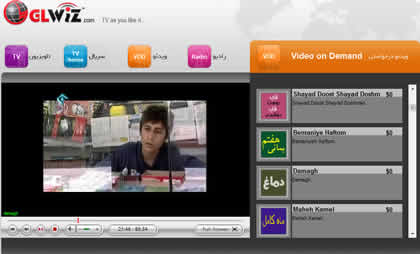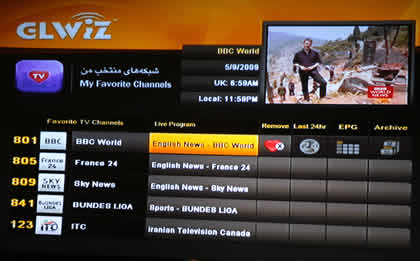 For the last three decades Iranian cinema has been very successful in the international scene. There are a lot of international film fans looking for a chance to watch Iranian films that don’t make their way to film festivals in order to get a better understanding of Iranian cinema and its quality. Film fans can now unite behind Gold Line’s GLbox. Now the internet service of GLwiz.com can be presented on your television by using the company’s box. You can access Iranian television and programs outside Iran including Voice of America and BBC in Farsi. You could watch on-demand items as well like sports items and, to the interest of our readers, movies.
For the last three decades Iranian cinema has been very successful in the international scene. There are a lot of international film fans looking for a chance to watch Iranian films that don’t make their way to film festivals in order to get a better understanding of Iranian cinema and its quality. Film fans can now unite behind Gold Line’s GLbox. Now the internet service of GLwiz.com can be presented on your television by using the company’s box. You can access Iranian television and programs outside Iran including Voice of America and BBC in Farsi. You could watch on-demand items as well like sports items and, to the interest of our readers, movies.
Inside the movies section, you will find a good selection of Iranian films. Not all of them are recent and some of them go back to the days of the previous president of Iran, Khatami. These are interesting to view because the films are so different than what many people have seen in film festivals or other media sources. Most of these films, such as Blue (pronounced Aw-bee in Farsi) are of young, well-to-do Iranians and their lifestyles. These films are actually well done and, especially this film, Blue, shows surprisingly great quality in its technical and storytelling aspects. The films rival some of the best of Hollywood, in that sense.
To start off with GLBox, you need to obtain a subscription to the service through GLwiz.com. You could use your computer to utilize the service, but if you want to watch these films on a big-screen TV, then your best bet is to buy a GLbox through the website. For $99, you’ll get the box and enroll in a $20/month payment plan (though GLwiz has a number of price packages available to choose from). The GLbox has a component, a composite and a S-VHS output. If you watch the composite output of GLWiz on an analog TV or monitor, you get a great picture. However, on a digital TV, the composite output quality is not very good, but of course, if you use the SVHS or component output, you get a much better picture. Also picture quality varies channel-to-channel. For example, if you’re watching BBC Farsi, the picture quality is excellent and close to watching a DVD. Quality really depends on the source and the quality if the individual stations and on-demand features.
to buy a GLbox through the website. For $99, you’ll get the box and enroll in a $20/month payment plan (though GLwiz has a number of price packages available to choose from). The GLbox has a component, a composite and a S-VHS output. If you watch the composite output of GLWiz on an analog TV or monitor, you get a great picture. However, on a digital TV, the composite output quality is not very good, but of course, if you use the SVHS or component output, you get a much better picture. Also picture quality varies channel-to-channel. For example, if you’re watching BBC Farsi, the picture quality is excellent and close to watching a DVD. Quality really depends on the source and the quality if the individual stations and on-demand features.
Upon receiving the box, you must register it online. When you register your GLbox, you are given a code which you enter on the actual set-top box during its configuration. At that point, you also select what type of internet connection you are utilizing with the box. For the highest quality, your best bet would be to use an Ethernet cord connection coming either from your broadband modem or a router. This also leaves the USB port in the back of the device free for other uses you may have (such as a wireless keyboard/mouse for web surfing). If you decide to go with the wireless option, then you better check GLwiz.com where they sell a specific USB adapter. GLwiz sells this certain adapter because the drivers are already installed onto the box and the devices work seamlessly together. I would recommend a connection of at least 2mbps as a minimum in order to use the box and watch TV shows and movies without any problems. Setting up the wireless connection only gets tricky when  entering your network specific information. Make sure you know the security information and usernames/passwords which may be necessary.
entering your network specific information. Make sure you know the security information and usernames/passwords which may be necessary.
To check your signal strength and connection speed, there is an actual speed test built into the menu. I encountered some set-backs when I actually conducted the speed test because the GLwiz box was maxing out at 2.6mbps on my wireless connection when I had already registered 18mbps on the Ethernet cord connection. A Tech representative from GLWiz explained that the operating system of the box is currently limited and that it will be updated in the near future. The update will enable users to receive faster wireless signals with the box and will bring flash video support as well. This means that you will be able to go onto YouTube and other video sites on your GLWiz box without a hitch.
I know that many houses and workplaces don’t have Ethernet cables running all the way to the back of their TV’s. Therefore, wireless is the only option for many. The problems that arise are often comprised of connection inconsistencies which lead to picture degradation.
Another solution that has been offered within the past 2 years is power-line networking. A pair of devices enables you to use your power-line as a network. You need only to plug one of the devices into a power outlet, insert an Ethernet cord into that device and then plug the other device (with the Ethernet output on it) in any electrical output in your home. The process essentially gives you internet connection wherever a power outlet exists.
power outlet, insert an Ethernet cord into that device and then plug the other device (with the Ethernet output on it) in any electrical output in your home. The process essentially gives you internet connection wherever a power outlet exists.
When starting up the GLbox, you’re greeted by the menu. Here you have the options of watching VOD or jumping to the IPTV service of GLwiz. There are a handful of stations which operate like cable networks and broadcast Iranian programs around the clock. If you are interested in viewing television series from Iran, there are a number of channels which broadcast them and many include subtitles as well. Unfortunately, when viewing films/shows in English or Farsi using GLbox’ VOD, the subtitles are missing-in-action. This takes a lot away from the movie-watching experience for users who don’t speak Farsi. Hopefully, the creators of GLWiz will take note of this. It would also be nice for some newer Iranian filmmakers, even ones who haven’t had a chance to submit to film festivals, to have their work accessible for audiences on GLWiz. Bahram Bazari is a great example of a superb Iranian filmmaker who hasn’t made his way out to major film festivals yet, and it would be great to have his films available. The GLWIZ.com is currently an astounding tool for Iranians and Farsi speaking communities around the world. And of course, with the availability of the GLbox in the U.S., many more individuals will be able to see films from Iran and watch television (including sports) from the region. The GLbox has enormous potential, and Goldline has experienced great success in their goal to bring Iranian television to living rooms in the United States.
****1/2
Weak: 1 Star Average: 2 Stars Good: 3 Stars Very Good: 4 Stars Excellent: 5 Stars

